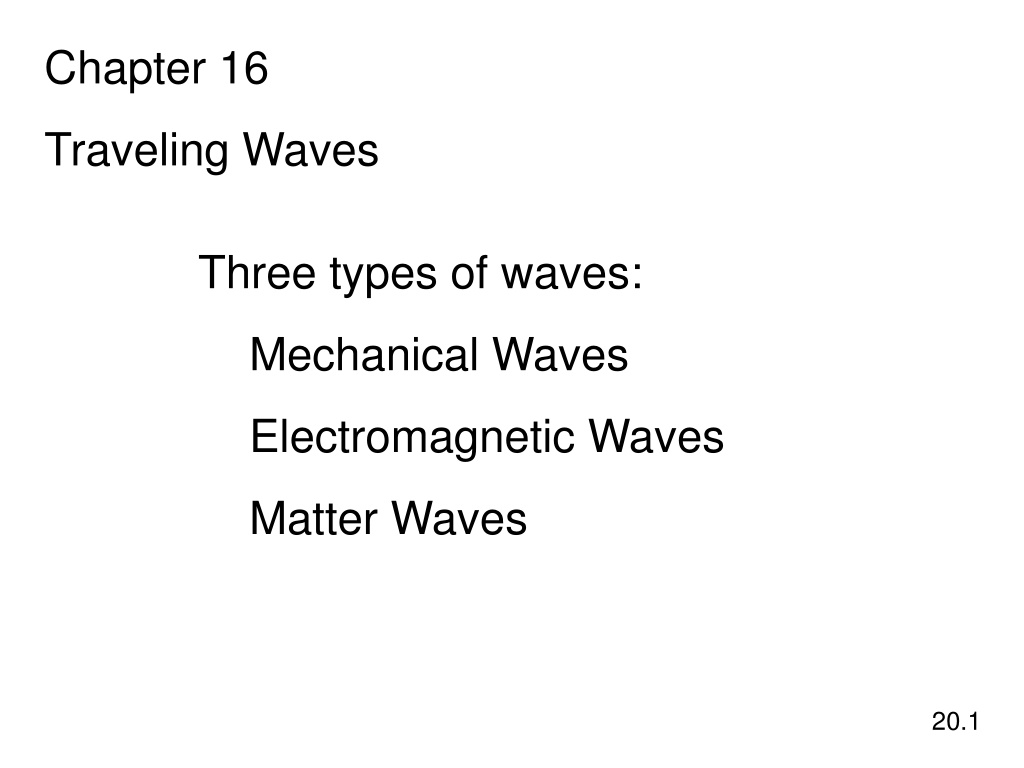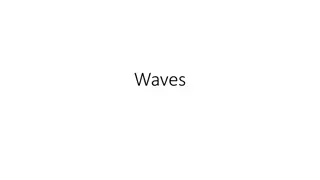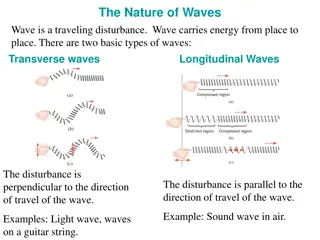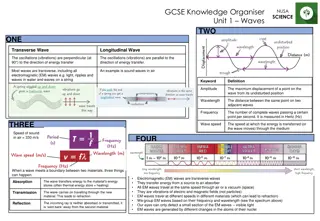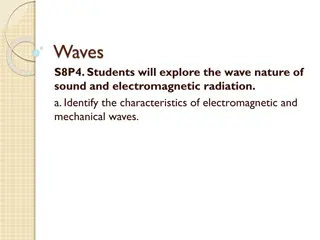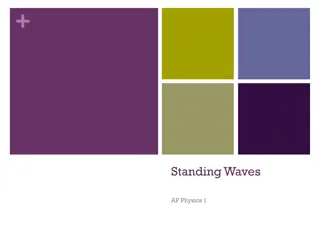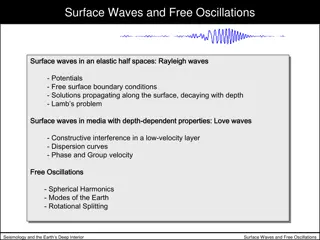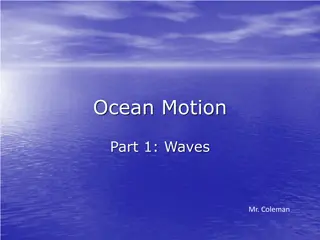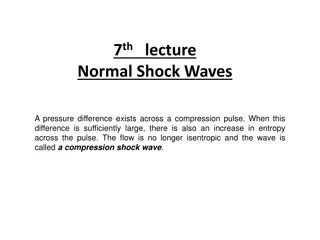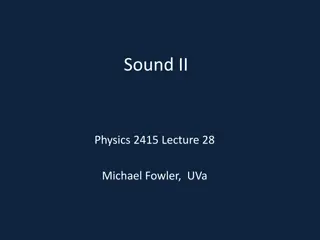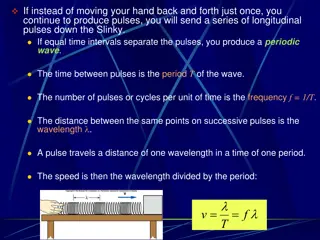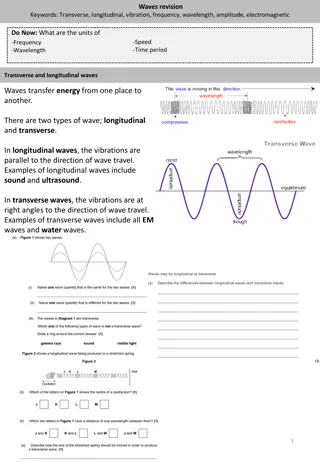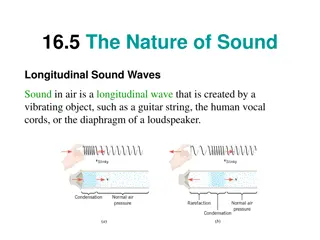Understanding Traveling Waves: Types, Properties, and Equations
Explore the world of traveling waves, including mechanical, electromagnetic, and matter waves. Learn about transverse and longitudinal wave motion, the speed of waves in strings, wave frequency, wavelength, and speed relationships, as well as wave equations for non-repeating waves over space and time. Delve into snapshot and history graphs depicting sinusoidal surfing waves hitting the beach, with examples like creating a snapshot graph of wave appearance from the beach and a history graph of buoy experiences. Dive into the fascinating realm of wave physics with practical examples and visuals.
Download Presentation

Please find below an Image/Link to download the presentation.
The content on the website is provided AS IS for your information and personal use only. It may not be sold, licensed, or shared on other websites without obtaining consent from the author. Download presentation by click this link. If you encounter any issues during the download, it is possible that the publisher has removed the file from their server.
E N D
Presentation Transcript
Chapter 16 Traveling Waves Three types of waves: Mechanical Waves Electromagnetic Waves Matter Waves 20.1
Two Types of Wave Motion: Transverse Waves Longitudinal Waves http://www.youtube.com/watch?v=CswoSQC_NX0
One-Dimensional Waves The speed of a wave in a stretched string can be found by: string T = v string Where T is the Tension in the string and is the linear density (in kg/m) of the string. 20.2
The frequency, wavelength and speed of a wave are related by: v = f
A certain rope has a mass of 0.70 kg and length 8.0 meters. If you pull on this rope with a force of 20N, at what speed will a wave travel down this rope? string T = v string
In our previous wave equation, we are looking at just the time component of a wave. When we send a single wave down a string, it s pretty easy to see that the wave is non-repeating over space and thus we have to create a new wave equation that will not only tell us what is happening in time, but also what is happening in space. = + ( , ) sin( ) D x t A kx t o D(x,t) thus gives you the distance your string has displaced itself from its equilibrium position at position x and time t. is the angular frequency k is the wave number 20.3
Snapshot Graphs vs. History Graphs A wave-train of beautifully sinusoidal surfing waves are hitting the beach once every 10 seconds. The speed of these waves are 5m/s and the trough to peak amplitude is 8 meters. = + ( , ) sin( ) D x t A kx t o Create a Snapshot Graph of what these waves look like as a function from distance from the beach. In Coastal Surf Report the eight meters is called the Swell and the 10 seconds in called the period.
Snapshot Graphs vs. History Graphs A wave-train of beautifully sinusoidal surfing waves are hitting the beach once every 10 seconds. The speed of these waves are 5m/s and the trough to peak amplitude is 8 meters. = + ( , ) sin( ) D x t A kx t o A buoy is anchored 500 meters from the shore. Create a History Graph of what the buoy experiences. In Coastal Surf Report the eight meters is called the Swell and the 10 seconds in called the period.
Snapshot Graphs vs. History Graphs Find the numerical values for k, and o. = + ( , ) sin( ) D x t A kx t o (Do not look up equations in your book!) In Coastal Surf Report the eight meters is called the Swell and the 10 seconds in called the period.
Snapshot Graphs vs. History Graphs = + ( , ) sin( ) D x t A kx t A tuning 523Hz tuning fork is emitting sound. Create a history graph of your eardrum. Sound travels at 331 m/s at STP. (Your eardrum experiences a total displacement of 1mm) o
Which of the following actions would make a pulse travel faster down a stretched string? 1. Move your hand up and down more quickly as you generate the pulse. 2. Move your hand up and down a larger distance as you generate the pulse. 3. Use a heavier string of the same length, under the same tension. 4. Use a lighter string of the same length, under the same tension. 5. Use a longer string of the same thickness, density and tension.
Which of the following actions would make a pulse travel faster down a stretched string? 1. Move your hand up and down more quickly as you generate the pulse. 2. Move your hand up and down a larger distance as you generate the pulse. 3. Use a heavier string of the same length, under the same tension. 4. Use a lighter string of the same length, under the same tension. 5. Use a longer string of the same thickness, density and tension.
What is the frequency of this traveling wave? 1. 10 Hz 2. 5 Hz 3. 2 Hz 4. 0.2 Hz 5. 0.1 Hz
What is the frequency of this traveling wave? 1. 10 Hz 2. 5 Hz 3. 2 Hz 4. 0.2 Hz 5. 0.1 Hz
What is the phase difference between the crest of a wave and the adjacent trough? 1. 0 2. /4 3. /2 4. 3 /2 5.
What is the phase difference between the crest of a wave and the adjacent trough? 1. 0 2. /4 3. /2 4. 3 /2 5.
Lets use the concept of phase shift to find the speed of sound in this room.
Electromagnetic Radiation Travels in a vacuum at a speed of c = 299,792,458 m/s (yes, this is a proper reporting of sig. figs) The speed of light is actually used as the current definition of the SI unit of length. http://www.mel.nist.gov/div821/museum/timeline.htm
~700nm ~350nm Wavelength = A M F M TV Micro waves X-Rays Gamma- Rays Infra- red Ultra- violet Low Energy High Energy Long Wavelength Small Wavelength Low Frequency High Frequency
Doppler Effect Doppler Effect for Sounds for an: v Approaching source or approaching observer 1 ( o ) f o v = f v or Receding source or a receding observer 1 ( ) s v v Doppler Effect for Light for a: 1 s c = Receding source 0 v 1 s or Approaching source c
You have a satellite orbiting the moon with an orbital radius of 2000km. The satellite is transmitting a carrier signal at 154.41MHz. Within what range will your receiver have to be able to detect a signal if you want to be able to receive the satellite s carrier frequency? Earth s moon mass =7.36 1022kg.
Power and Intensity Power Intensity Area Let s look at how intensity changes for a laser vs. a spherical point-source radiator
Sample Problem: A satellite orbiting the Earth measures the Intensity of the light from the sun to be 1400 Watts/m2. How much light energy does the sun put out per year? How much mass does the sun lose per year?
Summary of Topics covered in Chp. 20 Traveling waves can be modeled via the equation: = + ( , ) sin( ) D x t A kx t o is the angular frequency and is related to the normal frequency (f) or the period. k is the wave number and is related to the traveling wave s wavelength ( ). Phi is the phase constant. And A the amplitude. x is where you are looking and t is when you are looking D is the diplacement of the particle in question v v 1 ( o ) f o 1 s v = f c = The Doppler Effect: v 0 v 1 ( ) s 1 s v c Power Intensity Power and Intensity: Area
Sample Problems: Traveling Waves and the wave equation: Things you should be able to do for this type of problem: be able to model a traveling wave using an equation be able to determine physical quantities such as: v, f, k, and Be able to draw snap shot and history representations of a traveling wave. 20.53 A wave on a string is described by D(x,t) = (3.0cm)sin[2 (x/(2.4m) + t/(0.20s) +1)], where x is in m and t is in sec. a) In What direction is this wave traveling? b) What are the wave speed, the frequency, and the wave number? c) At t = 0.50 sec, what is the displacement of the string at 0.20m?
Sample Problems: The Doppler Effect v v 1 ( o ) f o 1 s v c = f = v 0 v 1 ( ) s 1 s v c A bat emits a sonic ping at a frequency of 50.0kHz. The bat is flying toward North at 3.0 m/s. You are bicycling South at 9.0 m/s. What frequency does the bat hear in the reflection off you of its ping ?
Sample Problems: Power Intensity Light and intensity Area A perfect 100 mW laser makes 1.0cm diameter dot on a wall 10 meters away. What is the intensity in that dot? A perfect 100 W light bulb emits light equally in all directions. What is the light intensity at a point on a wall 10 meters away from the bulb?
Sample problem: Calculate the power output of our sun. Given: A satellite in Earth s Orbit receives 1407Watts/m2(this is called the solar constant ).
